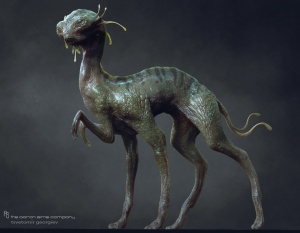Difference between revisions of "Invasion!/Yokai:Profile"
| Line 23: | Line 23: | ||
=== Genders & Reproduction === | === Genders & Reproduction === | ||
The Yokai can be either or any gender appropriate to a form they have decided to take on. However, even the oldest Yokai will need an additional 50% to the time it takes them to transform in order to adapt their gamates to be capable of reproducing viable offspring with another species. Any offspring born via methods other than the mammalian female method of reproduction will produce a normal member of whatever species they are imitating, perhapse with some faint psychic abilities. They will not have the embryonic stem-cell prodicing tails or the ability to transform unless they reproduce via the female mammalian method. They must bear the child within their own bodies in order to impart those abilities. | |||
=== Aging === | === Aging === | ||
=== Diet === | === Diet === | ||
Revision as of 10:56, 27 June 2017
Yokai
The Yokai are a species of ancient colonists who came to earth before it had developed any self-aware sentient life. They set down in a region on the east side of the Eurasia continent. Later as human life developed sentience the descendants of the Yokai colonists made the decision to hide themselves and keep interaction to a minimum, although there were those who broke this standard. The Yokai possess a shape-shifting ability which they had originally used to take on the appearance of a mammal local to their landing area known in the earth language as a "Kitsune" in the local language, or "Fox" in the current dominant English. They do have a weakness in their transformations that they can never cause their tails to fully vanish which renders then unable to add or remove limbs from their body, only change their appearance. Thus, in cases where they do take on a form like that of a human, they usually keep the tails they had in their fox form as they have grown more accustomed to those bushy tails over their own natural slimy tails.
Throughout the centuries, the local humans have created several stories in regards to the Yokai, attributing several abilities to them that they do not in fact possess. Most of the local folk-lore correctly attributes most of their abilities to the name "Kitsune," identifying the fox which is their preferred form with all of their capabilities as they are, but the same folk-lore has gone on from there to use the actual name of their species and attributed all manner of forms, abilities, and powers that far exceed anything they can actually do, although due to them having the ability to change their shape it is easy to see how this confusion could have happened.
The native Yokai colonist descendants are long removed from any technology or contact with their home planet. During the invasion, a landing party made contact with the native Yokai colonist descendants in order to warn them of the impending danger.
Abilities
Negligible Senescence The Yokai do not experience telomorase breakdown, and thus do not experience negative effects from aging. In fact, the older they live the stronger they become. You can often tell the age of a Yokai by the number of tails they have. They are born with one tail. Around age 50 or so they grow a second tail (give or take 10% of their age.) They then grow a third tail at around age 200, a fourth around age 500, and then they continue on at a logarithmic rate with greater age gaps between each tail. The oldest Yokai who are around 20,000 years of age have 9 tails, the 9th tail having grown in at around age 12,000. It is as of yet uncertain whether or not they are capable of growing a 10th tail.
Shape-changing abilities The Yokai have an abundance of stem-cells identical to the embryonic state of their species in their bodies, and the ability to mentally guide the apoptosis of some cells in some regions of their body and promote cell development in other parts of their body in order to alter their physical appearance. It takes a 1 tailed Yokai around a year of effort to take on any form they want, but a 9 tailed Yokai could alter their appearance in under a day. One thing a Yokai can never change though is that they absolutely cannot eliminate their tails beings their tails contain the organ that produces their plentiful stem-cells and this organ cannot be migrated. The tails must remain at bare minimum 4 inches long and 3 inches in diameter in order to preserve this function.
Enterprising and intelligent Yokai will often grant their skin chamilion-like color changing abilities, and ready an entire set of hair follicles in order to shorten the time they need to transform between similar forms that can be sped along simply by growing their hair or changing skin color. Such simple transformations can be completed even by 1 tailed Yokai in about 30 minutes.
Pyrokenisis The Yokai have the psychic ability to create and control fire. Flames that the Yokai create will always have a bluish-white color where as already existing flames they manipulate will have the color appropriate their original fuel source.
Biology
Genders & Reproduction
The Yokai can be either or any gender appropriate to a form they have decided to take on. However, even the oldest Yokai will need an additional 50% to the time it takes them to transform in order to adapt their gamates to be capable of reproducing viable offspring with another species. Any offspring born via methods other than the mammalian female method of reproduction will produce a normal member of whatever species they are imitating, perhapse with some faint psychic abilities. They will not have the embryonic stem-cell prodicing tails or the ability to transform unless they reproduce via the female mammalian method. They must bear the child within their own bodies in order to impart those abilities.
Aging
Diet
Senses
- Visual:
- Auditory:
- Chemical:
- Tactile:

